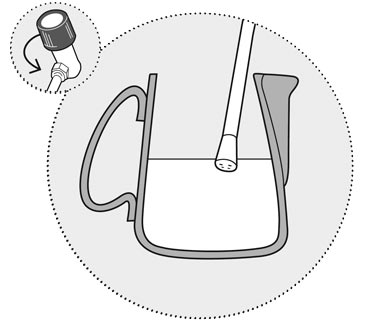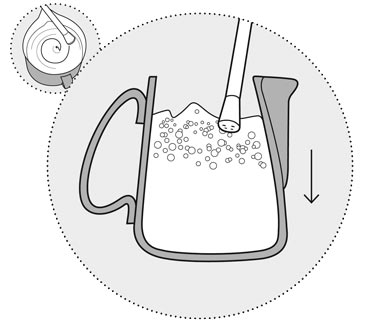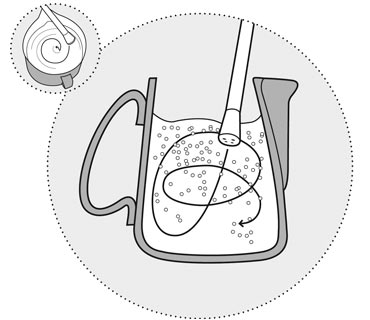A perfect espresso doesn’t fall from the skies.
The Italian espresso tradition requires four different elements for the perfect espresso: coffee blend, grinder, machine, human being. Figure it out.
Enjoy good living
Espresso — it is a wonderful accessory for good living and an extraordinary experience of taste. With an Olympia-Express, the perfect espresso will come home to you, enabling you to enjoy it, your own «Caffè». It will come as a pure espresso or as Americano, with a hazelnut coloured crema or as one of the other many variations.
The importance of the water
The quality of the water used is very important for the preparation of a good espresso. It is important not to use hard water, so the taste and the aroma of the ground beans can fully unfold.
The water hardness varies from region to region, depending on the potassium salts solved in it. A German hardness grade (°dh) complies with the content of 0.35 oz. limestone per 264.17 gallons of water. Many water filter manufacturers offer test cards, helping you to find out about the composition of your tap water and what hardness grade it is. We recommend a hardness grade from about 6 °dh (US: 0.336 ppm CaCO₃) A normal water filter filters the limestone out of the water, so that the aroma of the espresso can unfold fully.
Apart from the taste, there is also another reason why you should not use hard water. Limescale can cause crust formation in the pipes and the boiler and thus cause slow water flow. Limescale blockage can also cause a reduction in temperature of the outflowing water and thus affect the outcome.
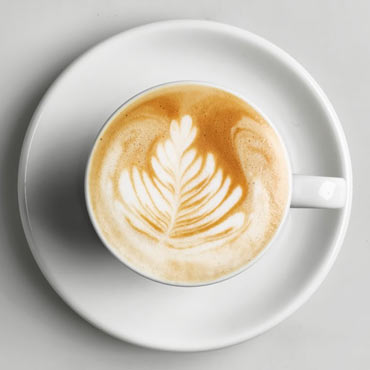
The importance of the bean
Most available coffee blends sold consist of two different coffee blends, which differentiate in taste, caffeine amount and shape. Arabica beans have a rounded cut in the middle, are longer and flatter. The unroasted beans have an intense green colour. The cut on the Robusta bean on the other hand is very straight, it is rounder and it is a little lighter in colour with brown or grey shading. Whereas the Robusta bean has high caffeine content, the Arabica beans are milder and more aromatic. Even though common opinion suggests that pure Arabica blends are better than ones with a small proportion of Robusta beans, it should be noted that a small Robusta part (about 10 %) intensifies the taste and the aroma; it also simplifies the espresso making procedure and compensates the traces of bitterness in Arabica beans.
Even though the roasted beans are enclosed in vacuum or valve packages and do not lose their characteristics for many months, they are, however, at their best within the first 3–4 weeks. We suggest a dry and airy place for storage. Warmth, light and strong aromas are to be avoided.
Espresso loses its aroma very quickly when exposed to air. Therefore, the packaging should only be opened just before filling it into the grinder. Because more taste is lost more quickly when the beans are grinded, only grind as much as you need.
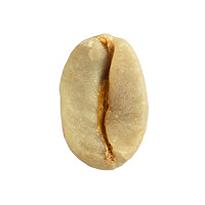
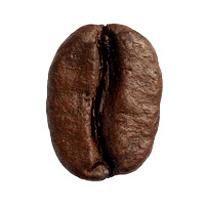
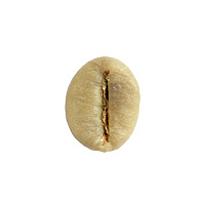
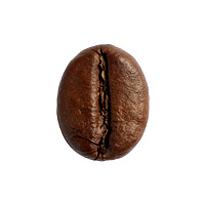
Perfect espresso in five steps
The preparation
The espresso machine should be switched on 15 minutes before use, so that the right temperature exists in all parts of the machine and the needed pressure has built up. Since most parts only really heat themselves when the espresso is being made, we suggest putting the portafilter with basket, but without espresso into the brew group and letting water flow through by lifting and lowering the lever. Repeat this action two to three times until the brew group and portafilter are hot.
The grinding
For the use of the grinder, please consider the advice offered to you later in this manual, entitled “The Moca”, the manual for your grinder. The setting of the grinder is extremely important, since it can alter the size of the grind. If the beans have been ground too coarsely, the water will flow through the grind too quickly and not all the desired aromatic parts will have been extracted. The result is a thin espresso that is poor in aroma. However, if the grind is too fine, the water will run through the coffee very slowly and the espresso will taste wooden and bitter. Endless factors, such as humidity, air pressure and quality, blend and roast temperature of the bean are of such high importance to the outcome that there is not “the” right grind setting.
The ideal grind setting is achieved when it takes 20 – 30 seconds to pull a single espresso shot.
The dosage
After the grinding, it is important to fill the basket in the portafilter with the right amount of espresso, the ideal amount would be between 0.27 oz and 0.32 oz. Not following these guidelines would mean that the same problems might occur as with the too coarse or too fine espresso grind. Please pay attention to the right choice of basket. If you select the wrong one, the outcome can be frustrating.
The tamping
The espresso in the portafilter basket has to be properly tamped down to provide the flowing water with the needed resistance: If the espresso is not tamped sufficiently, the water will run through the grind without picking up the entire aroma, if the espresso is tamped too hard, the water flow can be very slow or not happen at all.
The suggested force to be tamping with is 55.12 lb. For training purposes, we suggest that you use your bathroom scales, with a little practice you will find out the perfect tamping pressure.
The extraction
After tamping, place the portafilter, which holds the basket, counterclockwise into the brew group. If water or coffee spills out from the sides when you pull the lever down, you have either put in too much espresso grind or the portafilter is sitting too loosely in the brew group. Once it has been tightened, pull the lever up slowly, and then push it back down.
The result should be an aromatic, delicious espresso with a beautiful hazel-colored crema.
Preparation on a Cremina with Moca 2014
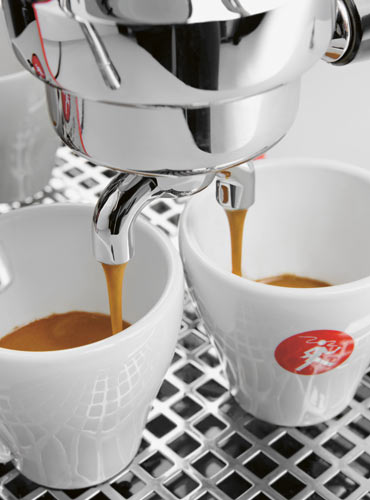
The result
If you have followed the instructions, the result is a perfect espresso. You can judge this by the following criteria:
The first impression
The color of the crema shows the caramelized natural sugars of the espresso bean. Ideally, the crema should be of a hazel color with shimmers of red irregular stripes (fig. 01). The crema should be three to four millimeters thick. It should not include any big bubbles and last a minimum of three minutes without breaking up or decomposing.
If the crema is light and thin, contains big bubbles and disappears quickly, it is a sign of insufficient use of the espresso grind (fig. 02). If the crema is dark brown or black with a white spot, or is too thin with the tendency to form a black hole in the middle, the espresso grind has been exhausted (fig. 03).
The aroma
The espresso flavor consists of many different substances. After the extraction of the shot(s), the aroma should be intense but pleasant and slightly sweet. The espresso should not be burned or taste wooden, smell musky or like tobacco.
A touch of hazelnut can develop when a blend with a high Arabica percentage is used. An unclear, weak or lack of smell is a sign of poor use of the espresso. A biting, sour taste or too dominant smell means the espresso has been exhausted.
The taste
A perfect espresso needs no sugar, however, but sugar can complete it. The taste of the espresso should be perfectly balanced between sweet and bitter. It should never taste burnt or leave a bitter aftertaste. A watery tasting espresso without the needed density is normally due to badly brewed espresso.
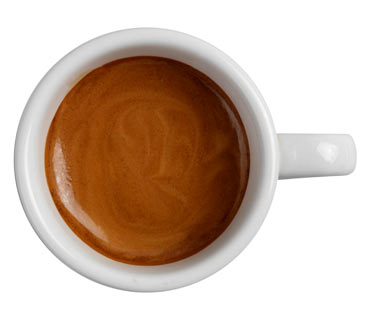
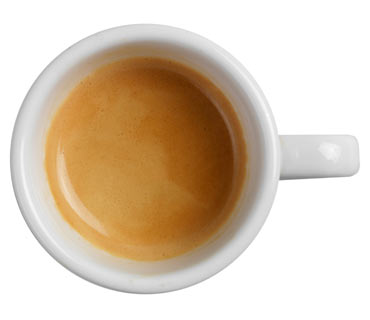
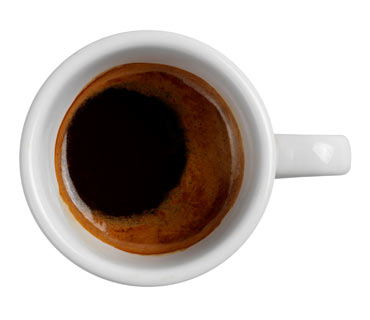
Milk froth creation
The making of perfect milk froth comes in two steps, the socalled “stretching and rolling”.
Fill the small steel container, until you reached the beginning of the spout, with cold and fresh milk. Chose any kind of milk that you desire. UHT milk, full-fat and semi-skimmed are as good for frothing as soya or goats’ milk, since they all provide the same protein content that is needed for good milk froth. Hold a clean damp cloth around the steam wand and nozzle and open the steam tab briefly.
Immerse the steam nozzle into the milk and open the steam tab fully. When the milk slowly starts to create froth, the container needs to be lowered slightly, whereby the tip of the steam wand always has to be slightly below the milk surface. When the volume has nearly doubled and reached 86 °F, the rolling phase starts. The steam wand should be placed deeper into the milk to mix the created froth with the hot milk. Through rotation, the frothed milk will get finer and finer. The big bubbles burst and the mixture will form to be a homogeneous fluid. Throughout this process, no up and down movements are necessary.
The ideal temperature can be checked by placing one hand on the container, if is it more than hand warm, but not hot, the optimal temperature of 149 °F has been reached. Then, close the steam tab and remove the container. Immediately after the use, release remaining steam from the steam wand and clean it with a damp cloth. By doing so, dirt and limestone will not build up around its tip or the inside.
